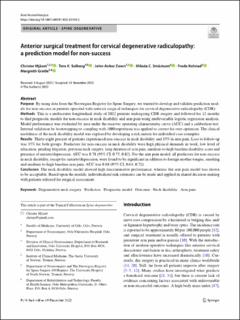| dc.contributor.author | Mjåset, Christer | |
| dc.contributor.author | Solberg, Tore | |
| dc.contributor.author | Zwart, John Anker Henrik | |
| dc.contributor.author | Småstuen, Milada Cvancarova | |
| dc.contributor.author | Kolstad, Frode | |
| dc.contributor.author | Grotle, Margreth | |
| dc.date.accessioned | 2023-01-09T14:13:26Z | |
| dc.date.available | 2023-01-09T14:13:26Z | |
| dc.date.created | 2022-12-25T10:52:08Z | |
| dc.date.issued | 2022 | |
| dc.identifier.citation | Acta Neurochirurgica. 2022, 1-13. | en_US |
| dc.identifier.issn | 0001-6268 | |
| dc.identifier.uri | https://hdl.handle.net/11250/3042045 | |
| dc.description.abstract | Purpose
By using data from the Norwegian Registry for Spine Surgery, we wanted to develop and validate prediction models for non-success in patients operated with anterior surgical techniques for cervical degenerative radiculopathy (CDR).
Methods
This is a multicentre longitudinal study of 2022 patients undergoing CDR surgery and followed for 12 months to find prognostic models for non-success in neck disability and arm pain using multivariable logistic regression analysis. Model performance was evaluated by area under the receiver operating characteristic curve (AUC) and a calibration test. Internal validation by bootstrapping re-sampling with 1000 repetitions was applied to correct for over-optimism. The clinical usefulness of the neck disability model was explored by developing a risk matrix for individual case examples.
Results
Thirty-eight percent of patients experienced non-success in neck disability and 35% in arm pain. Loss to follow-up was 35% for both groups. Predictors for non-success in neck disability were high physical demands in work, low level of education, pending litigation, previous neck surgery, long duration of arm pain, medium-to-high baseline disability score and presence of anxiety/depression. AUC was 0.78 (95% CI, 0.75, 0.82). For the arm pain model, all predictors for non-success in neck disability, except for anxiety/depression, were found to be significant in addition to foreign mother tongue, smoking and medium-to-high baseline arm pain. AUC was 0.68 (95% CI, 0.64, 0.72).
Conclusion
The neck disability model showed high discriminative performance, whereas the arm pain model was shown to be acceptable. Based upon the models, individualized risk estimates can be made and applied in shared decision-making with patients referred for surgical assessment | en_US |
| dc.language.iso | eng | en_US |
| dc.publisher | Springer | en_US |
| dc.rights | Navngivelse 4.0 Internasjonal | * |
| dc.rights.uri | http://creativecommons.org/licenses/by/4.0/deed.no | * |
| dc.subject | Degenerative neck surgery | en_US |
| dc.subject | Neck disability | en_US |
| dc.subject | Predictors | en_US |
| dc.subject | Outcome | en_US |
| dc.title | Anterior surgical treatment for cervical degenerative radiculopathy: A prediction model for non-success | en_US |
| dc.type | Peer reviewed | en_US |
| dc.type | Journal article | en_US |
| dc.description.version | publishedVersion | en_US |
| cristin.ispublished | true | |
| cristin.fulltext | original | |
| cristin.qualitycode | 1 | |
| dc.identifier.doi | 10.1007/s00701-022-05440-2 | |
| dc.identifier.cristin | 2097350 | |
| dc.source.journal | Acta Neurochirurgica | en_US |
| dc.source.pagenumber | 1-13 | en_US |

